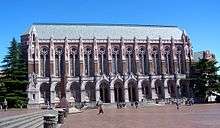University of Washington
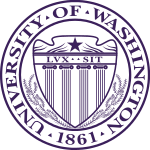 | |
| Motto | Lux sit (Latin)[1] |
|---|---|
Motto in English | Let there be light |
| Type | Public flagship |
| Established | 1861 |
| Endowment | $3.076 billion (2015)[2] |
| President | Ana Mari Cauce |
Academic staff | 5,803 |
Administrative staff | 16,174 |
| Students | 45,213[3] |
| Undergraduates | 31,099 |
| Postgraduates | 14,114 |
| Location |
Seattle, Washington, U.S. 47°39′18″N 122°18′29″W / 47.655°N 122.308°WCoordinates: 47°39′18″N 122°18′29″W / 47.655°N 122.308°W |
| Campus | Urban, 703 acres (2.8 km2) |
| Colors |
Purple & Gold[4] |
| Athletics | NCAA Division I – Pac-12 |
| Sports | 21 Varsity Teams |
| Nickname | Huskies ("Dawgs") |
| Mascot |
Harry the Husky, and Dubs (live Husky) |
| Affiliations | |
| Website |
www |
|
| |
The University of Washington, commonly referred to as simply Washington, UW, or informally U-Dub, is a public flagship research university based in Seattle, Washington, United States. Founded in 1861, Washington is one of the oldest universities on the West Coast.[5][6]
The university has three campuses: the oldest and largest in the University District of Seattle and two others in Tacoma and Bothell. Its operating expenses and research budget for fiscal year 2014–15 is expected to be $6.4 billion, continuing its historical record of being amongst the highest in the United States.[7] UW occupies over 500 buildings, with over 20 million gross square footage of space, including the University of Washington Plaza, the 325-foot (99 m) UW Tower, over 26 university libraries, as well as numerous conference centers.
Washington is a member of the Association of American Universities. In athletics, the university competes in the NCAA Division I Pac-12 Conference (Pac-12). Its athletic teams are called the Huskies.
History
The city of Seattle was one of several settlements in the mid to late 19th century vying for primacy in the newly formed Washington Territory. In 1854, territorial governor Isaac Stevens recommended the establishment of a university in Washington. Several prominent Seattle-area residents, chief among them Methodist preacher Daniel Bagley, saw the siting of this University as a chance to add to the city's prestige. They were able to convince early founder of Seattle and member of the territorial legislature Arthur A. Denny of the importance of Seattle winning the school. The legislature initially chartered two universities, one in Seattle and one in Lewis County, but later repealed its decision in favor of a single university in Lewis County, provided locally donated land could be found. When no site emerged, the legislature, encouraged by Denny, relocated the university to Seattle in 1858.
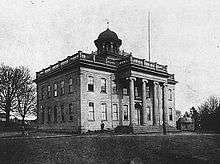
In 1861, scouting began for an appropriate 10 acres (4 ha) site in Seattle to serve as the campus for a new university. Arthur and Mary Denny donated eight acres, and fellow pioneers Edward Lander and Charlie and Mary Terry donated two acres to the university[8] at a site on Denny's Knoll in downtown Seattle. This tract was bounded by 4th and 6th Avenues on the west and east and Union and Seneca Streets on the north and south.
UW opened officially on November 4, 1861, as the Territorial University of Washington. The following year, the legislature passed articles formally incorporating the University and establishing a Board of Regents. The school struggled initially, closing three times: in 1863 for lack of students, and again in 1867 and 1876 due to shortage of funds. However, Clara Antoinette McCarty Wilt became the first graduate of UW in 1876 when she graduated from UW with a bachelor's degree in science. By the time Washington entered the Union in 1889, both Seattle and the University had grown substantially. Enrollment had increased from an initial 30 students to nearly 300, and the relative isolation of the campus had given way to encroaching development. A special legislative committee headed by UW graduate Edmond Meany was created for the purpose of finding a new campus better able to serve the growing student population. The committee selected a site on Union Bay northeast of downtown, and the legislature appropriated funds for its purchase and subsequent construction.
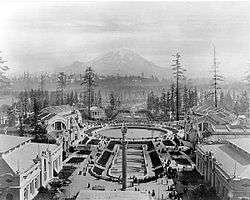
The university relocated from downtown to the new campus in 1895, moving into the newly built Denny Hall. The regents tried and failed to sell the old campus, and eventually settled on leasing the area. The University still owns what is now called the Metropolitan Tract. In the heart of the city, it is among the most valuable pieces of real estate in Seattle and generates millions of US$ in revenue annually.
The original Territorial University building was torn down in 1908 and its former site currently houses the Fairmont Olympic Hotel. The sole surviving remnants of UW's first building are four 24-foot (7.3 m), white, hand-fluted cedar, Ionic columns. They were salvaged by Edmond S. Meany—one of the University's first graduates and the former head of the history department. Meany and his colleague, Dean Herbert T. Condon, dubbed each of the columns "Loyalty," "Industry," "Faith" and "Efficiency," or "LIFE." The columns now stand in the Sylvan Grove Theater.[9]
Organizers of the 1909 Alaska-Yukon-Pacific Exposition eyed the still largely undeveloped campus as a prime setting for their world's fair. They came to an agreement with the Board of Regents that allowed them to use the campus grounds for the exposition. In exchange, the University would be able to take advantage of the development of the campus for the fair after its conclusion. This included a detailed site plan and several buildings. The plan for the A-Y-P Exposition prepared by John Charles Olmsted was later incorporated into the overall campus master plan and permanently affected the layout of the campus.

Both World Wars brought the military to the campus, with certain facilities temporarily loaned to the federal government. The subsequent post-war periods were times of dramatic growth for the University.[10] The period between the wars saw significant expansion on the upper campus. Construction of the liberal arts quadrangle, known to students as "The Quad," began in 1916 and continued in stages until 1939. The first two wings of Suzzallo Library, considered the architectural centerpiece of the University, were built in 1926 and 1935, respectively. Further growth came with the end of World War II and passage of the G.I. Bill. Among the most important developments of this period was the opening of the medical school in 1946. It would eventually grow into the University of Washington Medical Center, now ranked by U.S. News and World Report among the top ten hospitals in the United States. It was during this era in University of Washington history in which many Japanese Americans were sent away from the university to internment camps along the west coast of the United States as part of Executive Order 9066 following the attacks on Pearl Harbor. As a result, many Japanese American "soon-to-be" graduates were unable to receive their diplomas and be recognized for their accomplishment at the university until the University of Washington's commemoration ceremony for the Japanese Americans entitled The Long Journey Home held on May 18, 2008 at the main campus.
In the late 1960s, the University of Washington Police Department evolved from the University Safety and Security Division in response to anti-Vietnam War protests.[11] It currently has jurisdiction over the University of Washington campus and University-owned housing, except for the Radford Court apartments in Sand Point. The 1960s and 1970s are known as the "golden age" of the university due to the tremendous growth in students, facilities, operating budget and prestige under the leadership of Charles Odegaard from 1958 to 1973. Enrollment at UW more than doubled—from around 16,000 to 34,000—as the baby boom generation came of age. As was the case at many American universities, this era was marked by high levels of student activism, with much of the unrest focused around civil rights and opposition to the Vietnam War.[12][13] Odegaard instituted a vision of building a "community of scholars" and convinced the state of Washington legislatures to increase their investments towards the university. Additionally, Washington senators, Henry M. Jackson and Warren G. Magnuson used their political clout to funnel federal research monies to the University of Washington and to this day, UW is among the top recipients of federal research funds in the United States. The results included an operating budget increase of $37 million in 1958, to over $400 million in 1973, and 35 new buildings that doubled the floor space of the university.
The University opened campuses in Bothell and Tacoma in 1990. Initially, these campuses offered curricula for students seeking bachelor's degrees who have already completed two years of higher education, but both schools have transitioned to four-year universities, accepting the first freshman class in the fall of 2006. Both campuses offer master's degree programs as well. In 2009 the University opened an office in the Spanish city of León in collaboration with the local university.
Campus

The University of Washington, Seattle campus, is situated on the shores of Union and Portage Bays, with views of the Cascade Range to the east and the Olympic Mountains to the west. The main campus is bounded on the west by 15th Avenue N.E., on the north by N.E. 45th Street, on the east by Montlake Boulevard N.E., and on the south by N.E. Pacific Street. East Campus stretches east of Montlake Boulevard to Laurelhurst and is largely taken up by wetlands and sports fields. South Campus occupies the land between Pacific Street and the Lake Washington Ship Canal which used to be a golf course and is given over to the health sciences, oceanography, fisheries, and the University of Washington Medical Center. West Campus is less of a separate entity than the others, many of its facilities being on city streets, and stretches between 15th Avenue and Interstate 5 from the Ship Canal to N.E. 41st Street. University Way, known locally as "The Ave", lies nearby and is a focus for much student life at the university. At the heart of the university lies Red Square, which functions as the central hub of student interaction and hosts a variety of events annually.
Several major motion picture films were filmed on campus or used it as a backdrop, including The Sixth Man,[14] WarGames,[15] What the Bleep!?: Down the Rabbit Hole,[16] and 21 and Over.[17]
Organization and administration
University of Washington Interim President Ana Mari Cauce was selected president by the Board of Regents, effective October 13, 2015.[18] The previous President of the University of Washington was Michael K. Young. Phyllis Wise, who had previously served as Provost and Executive Vice President and for a year as Interim President, was named the Chancellor of the University of Illinois at Urbana-Champaign in August 2011.[19] On February 3, 2015, it was announced that Young will be next President of Texas A&M University.[20]
The University is governed by ten regents, one of whom is a student. Its most notable current regent is likely William H. Gates, Sr., father of Bill Gates. The undergraduate student government is the Associated Students of the University of Washington (ASUW) and the graduate student government is the Graduate and Professional Student Senate (GPSS).
The University offers bachelor's, master's and doctoral degrees through its 140 departments, themselves organized into various colleges and schools:[21]
|
|
Academics and research
In 2006, the University of Washington research budget passed the $1.0 billion milestone.[22] Virtually all of the funding came from peer-reviewed research proposals. UW research budget consistently ranks among the top 5 in both public and private universities in the United States.[23][24] UW is also the largest recipient of federal research funding among public universities and second among all public and private universities in the country, a position that the university has held each year since 1974.[25] The university is an elected member of the Association of American Universities.
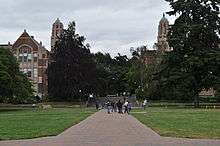
from center of Quad
UW students include 136 Fulbright Scholars, 35 Rhodes Scholars, 7 Marshall Scholars and 4 Gates Cambridge Scholars.[26] As of the 2011–12 autumn term, the university had 42,428 students, making it the largest university (in terms of student population) on the west coast.[27] About 33% of all undergraduates are members of minority groups.[28][29]
The University of Washington recruits faculty and staff from around the world.[30] Among the faculty, there are 151 members of American Association for the Advancement of Science, 68 members of the National Academy of Sciences, 67 members of the American Academy of Arts and Sciences, 53 members of the Institute of Medicine, 21 members of the National Academy of Engineering, 1 member of the National Academy of Public Administration, 7 Nobel Prize laureates, 2 Pulitzer Prize winners, 1 winner of the Fields Medal, 29 winners of the Presidential Early Career Awards in Science and Engineering, 15 Howard Hughes Medical Institute Investigators, 15 MacArthur Fellows, 9 winners of the Gairdner Foundation International Award, 5 winners of the National Medal of Science, 5 winners of Albert Lasker Award for Clinical Medical Research, 4 members of the American Philosophical Society, 2 winners of the National Book Award, and 2 winners of the National Medal of Arts.[31]
In May 2010, the University of Washington's six Nobel laureates were honoured by Crown Princess Victoria of Sweden, at a special dinner held in Seattle. They were Hans Georg Dehmelt, E. Donnall Thomas, Edwin G. Krebs, Edmond H. Fischer, Leland Hartwell and Linda Buck. The event was organized by Seattle’s Swedish Consulate as part of ‘Sweden Week’.[32]
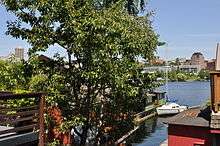
The University of Washington library system is the 18th largest library in the United States, with holdings of more than 7.5 million volumes.[33] The Association of Research Libraries ranked the UW library system between the top fifth and fifteenth in various categories.[34]
UW was also the host university of ResearchChannel program (now defunct), the only TV channel in the United States dedicated solely for the dissemination of research from academic institutions and research organizations.[35] Current participation of ResearchChannel includes 36 universities, 15 research organizations, two corporate research centers and many other affiliates.[36] UW also disseminates knowledge through its proprietary UWTV channel and online.[37]
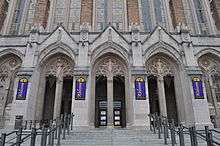
To promote equal academic opportunity, especially for people of low income, UW launched Husky Promise in 2006. Families of income up to 65 percent of state median income or 235 percent of federal poverty level are eligible. With this, up to 30 percent of undergraduate students may be eligible. The cut-off income level that UW set is the highest in the nation, making top quality education available to more people. Then UW President, Mark Emmert, simply said that being "elitist is not in our DNA".[38][39] "Last year, the University of Washington moved to a more comprehensive approach [to admissions], in which the admissions staff reads the entire application and looks at grades within the context of the individual high school, rather than relying on computerized cutoffs."[40]
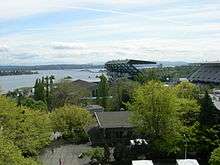
Since 1977, there has been a Transition School and Early Entrance Program on campus.[41]
In 2014, teams from the University of Washington School of Oceanography and the UW Applied Physics Laboratory successfully completed construction of the first high-power underwater cabled observatory in the United States.
Undergraduate admissions
The University of Washington's admissions process is "more selective" according to U.S. News & World Report.[42] For students entering Fall 2014, 17,451 freshmen were accepted out of 31,611 applicants, a 55.2% acceptance rate, and 6,361 enrolled.[43]
Among freshman students who enrolled in fall 2014, SAT scores for the middle 50% ranged from 540–660 for critical reading, 580–700 for math, and 450–660 for writing.[43] ACT composite scores for the middle 50% ranged from 25–31.[43] The middle 50% of high school GPA ranged from 3.64–3.93.[43]
Rankings and reputation
| University rankings | |
|---|---|
| National | |
| ARWU[44] | 13 |
| Forbes[45] | 75 |
| U.S. News & World Report[46] | 56 |
| Washington Monthly[47] | 14 |
| Global | |
| ARWU[48] | 15 |
| QS[49] | 59 |
| Times[50] | 25 |
| U.S. News & World Report[51] | 11 |
In international rankings University of Washington was ranked 15th among the world's top 500 universities by Academic Ranking of World Universities (ARWU) in 2015 and has been consistently regarded to be among the top 20 by that institution.[52] In the Times Higher Education World University Rankings (2016–17), it ranked 25th worldwide and its Times World Reputation Rankings for 2016 was 29th.[53] Meanwhile, QS World University Rankings (2016/17) ranked it 59th globally.
In U.S. rankings U.S. News & World Report ranked UW's undergraduate program tied for 52nd among "national universities" and tied for 16th among public universities in its 2016 rankings.[54] Among graduate programs, in 2015 U.S. News ranked UW's programs in primary care first, family medicine first, rural medicine first, clinical psychology second, library and information sciences third, social work third, statistics third (Department of Biostatistics) and seventh (Department of Statistics), nursing fourth, computer science sixth, public health sixth, education sixth, public affairs ninth, pharmacy tenth, research medicine tenth, business 23rd, engineering 27th and law 28th.[54] In the Washington Monthly National University Rankings, University of Washington ranked 7th in 2015.[55] The Top American Research Universities ranked University of Washington 11th among the top 50 American universities in 2010 published by The Center for Measuring University Performance, Arizona State University.[56]
Rankings published by institutions of other places: Leiden Ranking (2013) published by Leiden University of Netherlands ranked University of Washington 27th among the world 500 major universities.[57] In 2011, University of Washington ranked 8th among the world 2,000 universities in University Ranking by Academic Performance (URAP) published by Middle East Technical University.[58] At the same time, the Top 200 Colleges and Universities in the World on University Web Ranking published by 4 International Colleges & Universities placed it at 8th.[59]
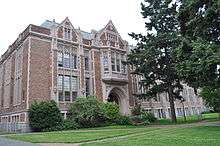
There are rankings for some specific domains as well. It ranked 13th among 300 Best World Universities in 2011 compiled by Human Resources & Labor Review (HRLR) on Measurements of World's Top 300 Universities Graduates' Performance .[60] In Kiplinger magazine's 2014 "Best Values in Public Colleges" list, the university ranked 11th for in-state students and 28th for out-of-state students[61] In 2011, the university ranked second among universities by number of undergraduate alumni currently serving as Peace Corps volunteers, at 110.[62] UW tied for third in 2010 (94 volunteers),[63] first in 2009 (101 volunteers),[64] first in 2008 (104 volunteers)[65] and first in 2007 (113 volunteers).[66] In the Global Language Monitor's rankings of universities by Internet presence, UW ranked 12th in 2012.[67] In 2012, SmartMoney named the University of Washington as 6th best salary returns on tuition.[68] The university was also listed as a "Public Ivy" in Greene's Guides in 2001.[69] Washington is an elected member of the American Association of Universities.[70]
Student life
| Student Body | Washington | U.S. Census | |
|---|---|---|---|
| African American | 3.42% | 3.6% | 12.0% |
| Asian American | 22.8% | 7.2% | 4.7% |
| White American | 48.0% | 72.5% | 63.7% |
| Hispanic American | 6.4% | 4.8% | 16.3% |
| Native American | 1.3% | 1.5% | 0.7% |
| International student | 14.3% | N/A | N/A |
| Other/Unknown | 3.1% | 5.2% | 2.4% |
The student newspaper is The Daily of the University of Washington, usually referred to as The Daily. It is the second largest daily in Seattle and is published every day classes are in session during fall, winter and spring quarters, and weekly during summer quarter. In 2010, The Daily launched a half-hour weekly television magazine show, "The Daily's Double Shot," broadcast UWTV, Channel 27.
The Beta (second) chapter of Phrateres collegiate philanthropic-social organization for women was established at the university in 1929.
The IMA Center for intramural sports was built in 1968. A $41 million remodel and expansion project began 2001 and the building was reopened in fall 2003 with a 95,000 square feet (8,800 m2) addition to its northwest to the original 40,000 square feet (3,700 m2) facility.[73][74][75] The facility includes two swimming pools and indoor track. North of the building, the project eliminated three of the nine outdoor tennis courts with the expansion, but included an all-weather FieldTurf surface for an existing intramurals field.
Athletics
UW students, sports teams, and alumni are called Washington Huskies, and often referred to metonymically as "Montlake," due to the campus's location on Montlake Boulevard N.E.[76] (although the traditional bounds of the Montlake neighborhood do not extend north of the Montlake Cut to include the campus.) The husky was selected as the school mascot by student committee in 1922. It replaced the "Sun Dodger," an abstract reference to the local weather that was quickly dropped in favor of something more tangible. The costumed "Harry the Husky" performs at sporting and special events, and a live Alaskan Malamute, currently named Dubs, has traditionally led the UW football team onto the field at the start of games. The school colors of purple and gold were adopted in 1892 by student vote. The choice was inspired by the first stanza of Lord Byron's The Destruction of Sennacherib:[77][78]
The Assyrian came down like the wolf on the fold,
And his cohorts were gleaming in purple and gold;
And the sheen of their spears was like stars on the sea,
When the blue wave rolls nightly on deep Galilee.[1]
- ^ "School Colors: Purple and Gold". CBS Interactive. Retrieved 8 July 2012.
The sports teams participate in the National Collegiate Athletic Association's Division I-A and in the Pac-12 Conference. Among its facilities on campus are Husky Stadium (football, track and field), the Alaska Airlines Arena at Hec Edmundson Pavilion (basketball, volleyball, and gymnastics), Husky Ballpark (baseball), Husky Softball Stadium, The Bill Quillian Tennis Stadium, The Nordstrom Tennis Center, Dempsey Indoor (Indoor track and field, football) and the Conibear Shellhouse (rowing). The golf team plays at the Washington National Golf Club and until recently, the swimming team called the Weyerhaeuser Aquatic Center and the Husky pool home. (The university eliminated its men's and women's swim teams in May 2009.)[79]
The football team is traditionally competitive, having won the 1960 and 1991 national title, to go along with eight Rose Bowl victories and an Orange Bowl title. From 1907 to 1917, Washington football teams were unbeaten in 64 consecutive games, an NCAA record.[80] Tailgating by boat has been a Husky Stadium tradition since 1920 when the stadium was first built on the shores of Lake Washington. The Apple Cup game is an annual game against cross-state rival Washington State University that was first contested in 1900 with UW leading the all-time series, 65 wins to 31 losses and 6 ties. College Football Hall of Fame member Don James is a former head coach.
hosts basketball and volleyball
The men's basketball team has been moderately successful, though recently the team has enjoyed a resurgence under coach Lorenzo Romar. With Romar as head coach, the team has been to six NCAA tournaments (2003–2004, 2004–2005, 2005–2006, 2008–2009, 2009–2010 and 2010–2011 seasons), 2 consecutive top 16 (sweet sixteen) appearances, and secured a No. 1 seed in 2005. On December 23, 2005, the men's basketball team won their 800th victory in Hec Edmundson Pavilion, the most wins for any NCAA team in its current arena.
Rowing is a longstanding tradition at the University of Washington dating back to 1901. The Washington men's crew gained international prominence by winning the gold medal at the 1936 Summer Olympics in Berlin, defeating the German and Italian crews much to the chagrin of Adolf Hitler who was in attendance.[81] In 1958, the men's crew furthered their lore with a shocking win over Leningrad Trud's world champion rowers at the Moscow Cup, resulting in the first American sporting victory on Soviet soil,[82][83] and certainly the first time a Russian crowd gave any American team a standing ovation during the Cold War.[84] The men's crew have won 46 national titles[85] (15 Intercollegiate Rowing Association, 1 National Collegiate Rowing Championship), 15 Olympic gold medals, two silver and five bronze. The women have 10 national titles and two Olympic gold medals. In 1997, the women's team won the NCAA championship.[85] The Husky men are the 2015 national champions.
Recent national champions include the softball team (2009), the men's rowing team (2015, 2014, 2013, 2012, 2011, 2009, 2007), NCAA Division I women's cross country team (2008), and the women's volleyball team (2005). Individually, Scott Roth was the 2011 NCAA men's Outdoor Pole Vault and 2011 & 2010 NCAA men's Indoor Pole Vault champion. James Lepp was the 2005 NCAA men's golf champion. Ryan Brown (men's 800 meters) and Amy Lia (women's 1500 meters) won individual titles at the 2006 NCAA Track and Field Championships. Brad Walker was the 2005 NCAA men's Outdoor and Indoor Pole Vault champion.
Husky Stadium is one of several places that may have been the birthplace of the crowd phenomenon known as "The Wave". It is claimed that the wave was invented in October 1981 by Husky graduate Robb Weller and UW band director Bill Bissel. Their opponent that afternoon was Stanford.
On May 1, 2009, the athletic department announced it was discontinuing both men's and women's swimming programs effective immediately due to budget cuts.[86]
Husky Stadium
The renovated Husky Stadium is the first and primary income source of a completely remodeled athletic district. This major remodel of the athletic village will take decades to complete, as it will take place at the same time as a massive project by the Washington State Department of Transportation on nearby highways and bridges. The stadium project consists of a new grand concourse, underground light-rail station (opened March 19, 2016[87]), enclosed west end of the stadium, replacement of bleachers with individual seating, removal of track and Huskytron, new press box, private box seating, lowering of the field, football offices, permanent seating in the east end zone that does not block the view of Lake Washington, and new and improved amenities, concession stands and bathrooms throughout. The cost for renovating the stadium was around $280 million with a seating capacity slightly lower than previous, at 70,138 seats. Husky Stadium is used for Graduation.
Student services
UW offers many services for its students and alumni, even beyond the standard offered by most colleges and universities. Its "Student Life" division houses 16 departments and offices that serve students directly and indirectly, including those below and overseen by Vice President and Vice Provost, Eric Godfrey.
- The UW Career Center
- Counseling Center

- Disability Resource Center
- Fraternity and Sorority Life
- Health and Wellness Programs
- Housing and Food Services
- Student Admissions
- Office of Ceremonies
- Office of the University Registrar
- Department of Recreational Sports (IMA)
- Student Activities and Union Facilities
- Student Financial Aid
- Student Publications (The Daily)
- Campus Police[88]
Student housing
New building construction and renovations are scheduled to take place through 2020. The plan includes the construction of three six-story residence halls and two apartment complexes in the west section of campus, near the existing Terry and Lander Halls, in Phase I, the renovation of six existing residence halls in Phase II, and additional new construction in Phase III. The projects will result in a net gain of approximately 2,400 beds. The Residence Hall Student Association (student government for the halls) is the second largest student organization on campus and helps plan fun events in the halls.
In addition to on-campus housing the undergraduate student government, Associated Students of the University Washington, provides a free service to students, faculty, and staff looking to live off-campus called Off-Campus Housing Affairs.[89] They provide a free online search engine to local housing and resources to assist first time renters.
The Greek System at UW has also been a prominent part of student culture for more than 115 years. It is made up of two organizational bodies, the Interfraternity Council (IFC) and the Panhellenic Association. The IFC looks over all 32 fraternities with 1900+ members and Panhellenic consists of all 18 sororities and 1900 members.
Student organizations

Hundreds of Registered Student Organizations (RSOs) dedicated to a wide variety of interest exist on campus through the Associated Student of the University of Washington. Some of these RSO interest areas include: academic, cultural/international, environmental, Greek life, political/social action, religious, sports, and science. Prominent examples are:
- The Dream Project: "The Dream Project teaches UW students to mentor first-generation and low-income students in King County high schools as they navigate the complex college-admissions process."[90]
- Student Philanthropy Education Program: Partnered with the UW's nonprofit, the UW Foundation, this group focuses on promoting awareness of philanthropy's importance through major events on campus.
- Rural Health Education (RHE): Promotes health in rural areas of Washington state primarily through monthly health fairs. Volunteers include students from a variety of backgrounds including: medical, pharmacy, and dental students. In addition, several health professionals from around the greater Seattle area actively participate.
- Students Expressing Environmental Dedication (SEED): SEED works with Housing and Food Services to increase the sustainability of the residence halls and dining areas.
- UW Earth Club: The Earth Club is interested in promoting the expression of environmental attitudes and consciousness through specialized events.
- UW Farm: The UW farm grows crops on campus and advocates urban farming in the UW community.
- Washington Public Interest Research Group (WashPIRG): WashPIRG engages students in a variety of activism causes, including environmental projects on campus and the community.[91]
- UW Sierra Student Coalition: SSC is dedicated to many larger environmental issues on campus and providing related opportunities to students.
- UW Delta Delta Sigma Pre-Dental Society (DDS): This is a club dedicated to serving pre-dental students and it provides a forum for discussion of dental related topics.[92]
- GlobeMed at UW: a student-run non-profit organization that works to educate about global poverty and its affect on health. The UW chapter is a part of a national network of chapters, each partnering with a grassroots organization at home or abroad. GlobeMed at UW is partnered with The MINDS Foundation which supports education about and treatment for mental illness in rural India.
Disability support
The DO-IT (Disabilities, Opportunities, Internetworking, and Technology) Center is a program run by the university which assists educational institutions to fully integrate all students, including those with disabilities, into Academic life. DO-IT runs many programs, including the DO-IT Scholars Program, and a database of information on the 'universal' design of educational facilities for students of all levels of physical and mental ability.[93] These design programs reduce systemic barriers which could otherwise hinder the performance of some students. DO-IT's universal design philosophies may also be applied to professional organizations and conferences.[94]
Song
The University of Washington Husky Marching Band performs at many Husky sporting events including all football games. The band was founded in 1929, and today it is a cornerstone of Husky spirit. The band marches using a traditional high step, and it is one of only a few marching bands left in the United States to do so. Like many college bands, the Husky band has several traditional songs that it has played for decades, including the official fight songs "Bow Down to Washington" and "Tequila", as well as fan-favorite "Africano". In addition to athletic events, the band also plays at various other events such as commencement and convocation.
Mascot
The University of Washington's costumed mascot is Harry the Husky.
The University of Washington also has hosted a long line of Alaskan Malamutes as mascots. The 13 dogs thus far have been:
- Frosty I (1922–29)
- Frosty II (1930–36)
- Wasky (1946)
- Wasky II (1947–53)
- Ski (1954–57)
- Denali (1958)
- King Chinook (1959–68)
- Regent Denali (1969–80)
- Sundodger (1981–91)
- King Redoubt (1992–97)
- Prince Redoubt (1998)
- Spirit (1999–2008)
- Dubs (2009– )
Originally the dogs were cared for by the Sigma Alpha Epsilon fraternity, followed by a 49-year tradition (1959–2008) of care by the Cross family (a UW professor followed by his son).
Sustainability
Then UW President Emmert signed the American College and University Presidents Climate Commitment.[95] To help follow through on this promise, the UW has created a Climate Action Team.[96] He has also created an Environmental Stewardship Advisory Committee (ESAC), which recently created an inventory of UW's greenhouse gas emissions,[97] an environmental stewardship coordinator position, and has formalized a policy on environmental stewardship to give full institutional support to the cause of campus sustainability.[98]
As of February 2006, the UW joined a partnership with Seattle City Light as part of their Green Up Program. All of Seattle campus' electricity is purchased from renewable sources.[99] Housing and Food Services (HFS) spends several million dollars annually on locally produced, organic, and natural foods. HFS does not use styrofoam containers for any of its facilities on campus, instead using compostable cups, plates, utensils, and packaging whenever possible. Students Expressing Environmental Concern (SEED) is funded by HFS and is responsible for most of the sustainable changes made to HFS. Several new residence halls are planned for 2020, all of which are expected to meet silver or gold LEED standards.[100] All new state-funded buildings and major renovations must meet a LEED standard of at least Silver.[101] The University of Washington was one of only six universities to receive the highest grade on the Sustainable Endowments Institute's College Sustainability Report Card 2008, an "A-".[102] The report card identified the UW as one of 15 Overall College Sustainability Leaders among the 300 institutions surveyed.[101]
Associated Students of the University of Washington
.png)
The Associated Students of the University of Washington (ASUW) is one of two Student Governments at the University of Washington, the other being the Graduate and Professional Student Senate. It is funded and supported by student fees, and provides services that directly and indirectly benefit them. The ASUW employs over 72 current University of Washington students, has over 500 volunteers, and spends $1.03 million annually to provide services and activities to the student body of 43,000 on campus.[103] The Student Senate was established in 1994 as a division of the Associated Students of the University of Washington. Student Senate is one of two official student governed bodies and provides a broad-based discussion of issues. Currently, the ASUW Student Senate has a legislative body of over 150 senators representing a diverse set of interests on and off campus.[104]
The ASUW was incorporated in the State of Washington on April 20, 1906.[105] On April 30, 1932 the ASUW assisted in the incorporation of the University Bookstore[106] which has been in continuous operation at the same location on University Way for over 70 years. The ASUW Experimental College, part of the ASUW, was created in 1968 by several University of Washington students seeking to provide the campus and surrounding community with a selection of classes not offered on the university curriculum.[107]
Notable alumni and faculty
Notable alumni of the University of Washington include U.S. Olympic rower Joe Rantz (1936); architect Minoru Yamasaki (1934); US Senator Henry M. Jackson (JD 1935); Baskin & Robbins co-founder Irv Robbins (1939); former actor, Hollywood Reporter columnist and TCM host Robert Osborne (1954); glass artist Dale Chihuly (BA 1965); Serial killer Theodore Robert Bundy (BA, Psychology 1972); Pulitzer Prize-winning author Marilynne Robinson (PhD 1977), martial artist Bruce Lee; saxophonist Kenny G (1978); MySpace co-founder Chris DeWolfe (1988); and actor and comedian Joel McHale (1995, MFA 2000).
In film
- 1965: The Slender Thread directed by Sydney Pollack
- 1979: The Changeling, directed by Peter Medak[108]
- 1983: WarGames, directed by John Badham[15]
- 1992: Singles, directed by Cameron Crowe[109]
- 1997: Prefontaine, directed by Steve James
- 1997: The Sixth Man, directed by Randall Miller[14]
- 1999: 10 Things I Hate About You, directed by Gil Junger[110]
- 2004: What the Bleep Do We Know: Down the Rabbit Hole, directed by William Arntz[16]
- 2007: Dan in Real Life, directed by Peter Hedges[111]
- 2013: 21 and Over, directed by Jon Lucas[17]
See also
- Friday Harbor Laboratories
- Internationales Kulturinstitut
- List of forestry universities and colleges
- Manastash Ridge Observatory
- Theodor Jacobsen Observatory
- University of Washington Educational Outreach
- University of Washington firebombing incident
References
- ↑ Buhain, Venice (May 25, 1999). "But what does it mean?". The Daily.
- ↑ As of June 30, 2015. "U.S. and Canadian Institutions Listed by Fiscal Year (FY) 2015 Endowment Market Value and Change in Endowment Market Value from FY 2014 to FY 2015" (PDF). National Association of College and University Business Officers and Commonfund Institute. 2016.
- ↑ As of Fall 2014 "Fast Facts: 2015" (PDF). University of Washington.
- ↑ "Colors". University of Washington. Retrieved December 3, 2016.
- ↑ "Academic Ranking of World Universities in Clinical Medicine and Pharmacy – 2013". Center for World-Class Universities at Shanghai Jiao Tong University. Retrieved December 9, 2013.
- ↑ "Best Medical Schools: Research – 2013". US News and World Report. Retrieved December 9, 2013.
- ↑ "Executive Summary – Fiscal Year 2015 (FY15) Operating Budget, Tuition Item, and Capital Budget" (PDF). University of Washington. Retrieved June 16, 2014.
- ↑ Bhatt, Sanjay (October 3, 2013), "UW has big plans for its prime downtown Seattle real estate", The Seattle Times
- ↑ "The University of Washington's Early Years". No Finer Site: The University of Washington's Early Years On Union Bay. University Libraries. University of Washington. Retrieved April 29, 2015.
- ↑ "University of Washington". Great Depression in Washington State Project.
- ↑ "UW Police Department: History". Retrieved August 20, 2012.
- ↑ "The Black Student Union at UW: Black Power on Campus". Seattle Civil Rights and Labor History Project.
- ↑ Kindig, Jesse. "Student Activism at UW, 1948–1970". Seattle Civil Rights and Labor History Project.
- 1 2 Van Gelder, Lawrence (March 28, 1997). "The Sixth Man (1997) Hoop Dreams and (Ghostly) Schemes". The New York Times. Retrieved July 7, 2012.
- 1 2 "Filming Locations for WarGames". International Movie Database. Retrieved October 8, 2012.
- 1 2 "Movie – What the Bleep!? Down the Rabbit Hole (2006)". Retrieved October 8, 2012.
- 1 2 "Movie filming on University of Washington campus". King 5 News. August 29, 2011. Retrieved October 8, 2012.
- ↑ "Office of the President". www.washington.edu. Retrieved November 2, 2015.
- ↑ "Biography – Phyllis Wise". University of Illinois. Retrieved October 7, 2012.
- ↑ "Regents: Two-time university president expected to serve at helm of Texas A&M". theeagle.com. February 3, 2015. Retrieved February 3, 2015.
- ↑ "Academic Departments". University of Washington. Retrieved September 16, 2010.
- ↑ "UW passed $1 billion research budget mark". Uwnews.washington.edu. Retrieved June 30, 2012.
- ↑ "University of Washington Annual Report 2005" (PDF). Retrieved June 30, 2012.
- ↑ "The Top American Research Universities (December 2005)". Mup.asu.edu. Retrieved June 30, 2012.
- ↑ University of Washington (2008), Annual Report Of Awards And Expenditures Related To Research, Training, Fellowships, and Other Sponsored Programs (PDF), University of Washington
- ↑ "Future Students, University of Washington". 2012.
- ↑ "Office of Admissions. University of Washington". Admit.washington.edu. May 1, 2012. Retrieved June 30, 2012.
- ↑ "Undergraduates." Office of News and Information. University of Washington. Archived September 5, 2010, at the Wayback Machine.
- ↑ Shelley, Anthony (April 24, 2007). "UW admissions more competitive". The Daily of the University of Washington.
- ↑ "Faculty & Staff, University of Washington". 2012.
- ↑ University of Washington. "Faculty Memberships and Awards". Retrieved June 10, 2012.
- ↑ Trujillo, Joshua (May 7, 2010). "Crown Princess Victoria of Sweden honors local Nobel Laureates". The Seattle Post Intelligencer. Retrieved October 8, 2012.
- ↑ "American Library Association: The Nation's Largest Libraries". 2012.
- ↑ "ARL Statistics 2003-4" (PDF). Association of Research Libraries. 2005.
- ↑ ResearchChannel contact UW
- ↑ ResearchChannel participants
- ↑ "UWTV". UWTV. Retrieved June 30, 2012.
- ↑ Jaschik, Scott (October 13, 2006). "Inside HigherEd Husky Promise". Insidehighered.com. Retrieved June 30, 2012.
- ↑ "UW Husky Promise". Depts.washington.edu. October 11, 2006. Retrieved June 30, 2012.
- ↑ "Education News - College Admissions, MBA Programs, Financial Aid - Wsj.com". Collegejournal.com. Retrieved June 30, 2012.
- ↑ "The Halbert and Nancy Robinson Center for Young Scholars". Retrieved May 24, 2009.
- ↑ "University of Washington". U.S. News & World Report. Retrieved January 11, 2015.
- 1 2 3 4 "University of Washington Quick Facts". University of Washington.
- ↑ "Academic Ranking of World Universities 2016: USA". Shanghai Ranking Consultancy. Retrieved August 16, 2016.
- ↑ "America's Top Colleges". Forbes. July 5, 2016.
- ↑ "Best Colleges 2017: National Universities Rankings". U.S. News & World Report. September 12, 2016.
- ↑ "2016 Rankings - National Universities". Washington Monthly. Retrieved September 6, 2016.
- ↑ "Academic Ranking of World Universities 2016". Shanghai Ranking Consultancy. 2016. Retrieved August 16, 2016.
- ↑ "QS World University Rankings® 2016/17". Quacquarelli Symonds Limited. 2016. Retrieved September 6, 2016.
- ↑ "World University Rankings 2016-17". THE Education Ltd. Retrieved September 21, 2016.
- ↑ "Best Global Universities Rankings: 2017". U.S. News & World Report LP. Retrieved October 25, 2016.
- ↑ "Academic Ranking of World Universities——University of Washington".
- ↑ "World Reputation Rankings 2016". Times Higher Education.
- 1 2 "U.S. News Best Colleges Rankings". U.S. News & World Report. Retrieved October 1, 2015.
- ↑ "National University Rankings 2014". Washingtonmonthly.com. August 25, 2014.
- ↑ "2010 Top American Research Universities Report" (PDF). Retrieved June 30, 2012.
- ↑ "Leiden Ranking 2012/2012 by Leiden University". Leidenranking.com. Retrieved June 30, 2012.
- ↑ "Ranking by Academic Performance 2011, Middle East Technical University". Urapcenter.org. Retrieved June 30, 2012.
- ↑ Top 200 Colleges and Universities in the World 2012, 4 International Colleges & Universities
- ↑ "World Top 300 Universities Alumni Ranking". Chasecareer.net. Retrieved June 6, 2012.
- ↑ Best Values in Public Colleges (2014). Kiplinger.
- ↑ "Peace Corps Top Colleges 2012" (PDF). Retrieved June 30, 2012.
- ↑ "Peace Corps Top Colleges 2011" (PDF). Retrieved June 30, 2012.
- ↑ "Peace Corps Top Colleges 2010," Peace Corps.
- ↑ "Peace Corps Top Colleges 2009" (PDF). Retrieved June 30, 2012.
- ↑ "Peace Corps Top Colleges 2008" (PDF). Retrieved June 30, 2012.
- ↑ "2012 Top 300 US Colleges by Internet Media Buzz: Harvard Returns to the Top – August 30, 2011 – Global Language Monitor". Languagemonitor.com. Retrieved June 30, 2012.
- ↑ "SmartMoney College Rankings" (PDF). SmartMoney. Retrieved December 2, 2012.
- ↑ Greenes' Guide to Educational Planning:The Public Ivies – Howard Greene, Matthew W. Greene – Google Boeken. Books.google.com. Retrieved on August 7, 2013.
- ↑ "Association of American Universities". Retrieved March 16, 2012.
- ↑ "University of Washington Quick Stats" (PDF). UW Office of the Registrar. Retrieved April 23, 2014.
- ↑ See Washington (state)#Demographics and Demographics of the United States for references.
- ↑ Sengul, Andrew (September 29, 2003). "New Ima Opens To Students". The Daily. Retrieved August 14, 2012.
- ↑ "Up and Coming: Fun and Fitness, IMA Addition". University of Washington. Retrieved September 25, 2011.
- ↑ "Appendix G: List of Campus Buildings" (PDF). University of Washington. Retrieved August 14, 2012.
- ↑ Thiel, Art (January 21, 2007). "Mora's move generates intrigue". Seattle Post-Intelligencer. Retrieved September 16, 2010.
- ↑
- ↑ "University Chronology". University of Washington. Retrieved July 8, 2012.
- ↑ Condotta, Bob (May 2, 2009). "Huskies | UW cuts swimming teams | Seattle Times Newspaper". Seattletimes.com. Retrieved January 13, 2014.
- ↑ "2014 NCAA Football Record Book" (PDF). NCAA. p. 117. Retrieved October 17, 2014.
- ↑ Raley, Dan (December 21, 1999). "Events of the century". Seattle Post Intelligencer. Retrieved October 8, 2012.
- ↑ Johns, Greg (August 23, 2007). "Huskies crew earns return trip to Moscow". Seattle PI. Retrieved July 7, 2012.
- ↑ Thiel, Art (September 4, 2007). "UW crew gets front seat to history". Seattle PI. Retrieved July 7, 2012.
- ↑ Water World, Sports Illustrated, November 17, 2003.
- 1 2 Raley, Dan (April 30, 2003). "Crew: UW's most successful, stable athletic enterprise". Seattle PI. Retrieved July 7, 2012.
- ↑ "Washington Athletics Reduces Workforce, Streamlines Operations – University of Washington Official Athletic Site". Gohuskies.com. May 13, 2009. Retrieved June 30, 2012.
- ↑ "University Link light-rail service starts March 19". The Seattle Times. 2016-01-26. Retrieved 2016-05-06.
- ↑ http://police.uw.edu/
- ↑ "Off-Campus Housing Affairs". ASUW.
- ↑ "UW Dream Project | Supporting Seattle-area high school students through the college admissions process". Washington.edu. June 28, 2013. Retrieved January 13, 2014.
- ↑ "Student Organizations". Retrieved September 16, 2010.
- ↑ "DDS".
- ↑ "Universal Design: Process, Principles, and Applications". Washington.edu. June 14, 2012. Retrieved June 30, 2012.
- ↑ "Applications of Universal Design to Projects, Conference Exhibits, Presentations, and Professional Organizations". Washington.edu. Retrieved June 30, 2012.
- ↑ "Who's Who". American College & University. Presidentsclimatecommitment.org. Retrieved September 16, 2010.
- ↑ Roseth, Robert (February 5, 2009). "UW seeks to deepen its commitment to sustainability". Retrieved September 16, 2010.
- ↑ "About the Environmental Stewardship Advisory Committee (ESAC)" (PDF). Environmental Stewardship Advisory Committee. August 10, 2004. Retrieved September 16, 2010.
- ↑ "Environmental Stewardship Advisory Committee". University of Washington. Retrieved May 21, 2008.
- ↑ "Mayor Announces UW Green Energy Purchase". City of Seattle. February 2006.
- ↑ "Housing and Food Services: Environmental Stewardship and Sustainability". University of Washington. Archived from the original on July 25, 2010.
- 1 2 "UW again receives grade of A- for sustainability". September 26, 2008. Retrieved September 16, 2010.
- ↑ "College Sustainability Report Card 2008". Sustainable Endowments Institute. Retrieved May 21, 2008.
- ↑ "Associated Students of the University of Washington | SAF | Services and Activities Fee". depts.washington.edu. Retrieved November 9, 2015.
- ↑ "History". senate.asuw.org. Retrieved November 9, 2015.
- ↑ "Corporations Division". Washington Secretary of State. Retrieved October 28, 2011.
- ↑ "Corporations Division". Washington Secretary of State. Retrieved October 28, 2011.
- ↑ exco.org :: About the Experimental College
- ↑ "The Changeling (1980)". The New York Times. Retrieved July 7, 2012.
- ↑ Maslin, Janet (September 18, 1992). "Singles (1992) Review/Film; Youth, Love and a Place of One's Own". The New York Times. Retrieved July 7, 2012.
- ↑ Holden, Stephen (March 31, 1999). "10 Things I Hate About You (1999) FILM REVIEW; It's Like, You Know, Sonnets And Stuff". The New York Times. Retrieved July 7, 2012.
- ↑ Scott, A.O. (October 26, 2007). "A Family Just Like Yours (if You Lived in a Movie)". The New York Times. Retrieved July 7, 2012.
External links
| Wikimedia Commons has media related to University of Washington. |
| Wikisource has the text of a 1905 New International Encyclopedia article about University of Washington. |
- Official website
- University of Washington Athletics website
- A College of Fisheries: The University of Washington Operates a Unique Department for the Study of Commercial Fishing, Pacific Marine Review, 1921
- University of Washington Libraries Digital Collections – Calvin F. Todd Photographs Collection includes images from 1905 to 1930 of the University of Washington campus and scenes from Seattle including the waterfront, various buildings especially apartments, regrading activities, and the Pike Place Market.
- University of Washington Libraries Digital Collections – University of Washington Campus Photographs Photographs reflecting the early history of the University of Washington campus from its beginnings as the Territorial University through its establishment at its present site on the shores of Lake Washington. The database documents student activities, buildings, departments, and athletics.
-
 "Washington, University of". Collier's New Encyclopedia. 1921.
"Washington, University of". Collier's New Encyclopedia. 1921.
